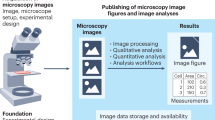Abstract
Modifying images for scientific publication is now quick and easy due to changes in technology. This has created a need for new image processing guidelines and attitudes, such as those offered to the research community by Doug Cromey (Cromey 2010). We suggest that related changes in technology have simplified the task of detecting misconduct for journal editors as well as researchers, and that this simplification has caused a shift in the responsibility for reporting misconduct. We also argue that the concept of best practices in image processing can serve as a general model for education in best practices in research.
Similar content being viewed by others
Notes
This point was emphasized by John Krueger of Office of Research Integrity, US Department of Health and Human Services, personal communication.
A similar suggestion was made by Jeffrey Cohen at the Society of Research Administrators International 2006 Annual Meeting in Quebec.
References
Cromey, D. (2010). Avoiding Twisted Pixels: Ethical guidelines for the appropriate use and manipulation of scientific digital images. Science and Engineering Ethics. doi 10.1007/s11948-010-9201-y.
Matchett, N. J. (2007). Frameworks. Center for Ethical Deliberation. http://mcb.unco.edu/ced/frameworks/. Accessed 20 July 2010.
Parrish, D., & Noonan, B. (2009). Image manipulation as research misconduct. Science and Engineering Ethics, 15(2), 161–167.
Pearson, H. (2006). Forensic software traces tweaks to images. Nature, 439, 520–521.
Vollmer, S. H., & Matchett, N. J. (2009). Incorporating Ethics Into RCR Courses. Newsletter. Office of Research Integrity, 18(1), 1. http://ori.dhhs.gov/documents/newsletters/vol18_no1.pdf. Accessed 20 July 2010.
Author information
Authors and Affiliations
Corresponding author
Rights and permissions
About this article
Cite this article
Benos, D.J., Vollmer, S.H. Generalizing on Best Practices in Image Processing: A Model for Promoting Research Integrity. Sci Eng Ethics 16, 669–673 (2010). https://doi.org/10.1007/s11948-010-9226-2
Received:
Accepted:
Published:
Issue Date:
DOI: https://doi.org/10.1007/s11948-010-9226-2




